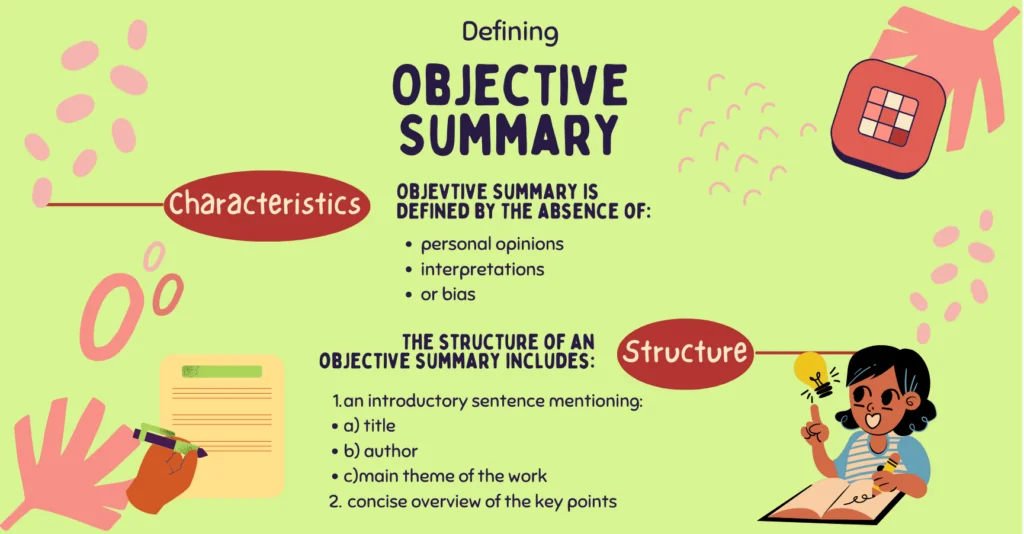Imagine you’ve just finished reading a fascinating book or article and want to share its essence with a friend concisely and accurately. This is where the art of writing an objective summary comes into play. For students, mastering this skill is not only crucial for academic success but also a valuable tool in navigating the vast sea of information in today’s world.

✅ AI Essay Writer ✅ AI Detector ✅ Plagchecker ✅ Paraphraser
✅ Summarizer ✅ Citation Generator
Defining an Objective Summary
An objective summary is what allows you to distill big chunks of information into a manageable, digestible form. As students, you’re constantly bombarded with details from textbooks, lectures, articles, and media, so using the skill of writing such summaries may come in handy. You basically take a snapshot of the main ideas and key points, capturing them without the distortion of personal opinions or interpretations. This makes it an invaluable tool for study, research, and communication.

An objective summary has a clear structure that helps your reader quickly grasp the essence of the original work. It usually starts with an introductory sentence that sets the stage by mentioning the title, author, and main theme of the piece. This is followed by a concise overview of the key points, presented in a logical order that mirrors the organization of the original text.
Let’s dive into a full example to see how this works in practice:
Original Text Excerpt:
In the article “The Impact of Climate Change on Agriculture,” John Doe discusses how global warming is altering farming practices worldwide. He highlights the increasing unpredictability of weather patterns, the shift in crop growing seasons, and the emergence of new pests and diseases as significant challenges for farmers. Doe concludes that adapting to these changes is crucial for the future of agriculture.
Objective Summary:
In “The Impact of Climate Change on Agriculture,” John Doe examines the effects of global warming on farming. He identifies key challenges such as unpredictable weather, changing growing seasons, and new pests and diseases. Doe emphasizes the importance of adapting agricultural practices to ensure future sustainability.
In this example, the summary captures the main points of the article without adding any personal interpretation. It concisely presents the problems identified by the author (unpredictable weather, shifting growing seasons, new pests) and the proposed solution (adaptation). This objective summary provides a clear, neutral overview of the article, making it easier for you to understand and remember the key information.
When You Need to Write an Objective Summary
For you as a student there will be various instances where writing an objective summary is not just useful, but necessary. These situations span across academic and professional fields, each with its unique requirements and purposes.
In academia:
- Summarizing Lectures
After a content-rich lecture, you might need to condense the information into a study note that captures the key points. This helps in reviewing and retaining the material for exams. - Condensing Articles for Research Papers
When writing research papers, you often have to integrate information from multiple sources. An objective summary of each article can help you understand and compare different viewpoints and findings. - Brief Overview of Books for Class Discussion
Before discussing a book in class, a summary can provide a quick refresher of the main themes and arguments, ensuring you’re prepared to engage in the conversation. - Summarizing Case Studies
In subjects like business or law, you might need to summarize complex case studies, focusing on the essential facts and outcomes to analyze and discuss in class.
In professional life:
- Creating Abstracts for Research Papers
When publishing research, an abstract is a must. It’s essentially an objective summary that provides a snapshot of your study’s purpose, methodology, findings, and conclusions. - Summarizing Findings in Reports
In a professional setting, you may need to summarize the findings of a report for colleagues or superiors. This helps in conveying important information quickly and efficiently. - Providing Updates in Business Communications
Whether it’s a progress report, a project update, or a briefing, an objective summary can communicate the key points without overwhelming the reader with details. - Developing Content for Newsletters or Websites
In roles related to communication or marketing, you might need to summarize news articles, research, or other content to fit the space and attention span of your audience.
In each of these contexts, the goal is to communicate the essential information as clearly and concisely as possible, without personal bias or unnecessary details. Mastering the art of writing objective summaries can significantly enhance your effectiveness in both academic and professional settings. You may also consider testing the summarizer generator to solve the issue.
How to Write an Objective Summary
If you decide to sit down and finally write that objective summary you were given for homework weeks ago, consider that you will need to pay attention to detail and take a methodical approach to your writing. We’ve compiled the following guide to help you build this work process more efficiently.
1. Read the Source Material
Start by thoroughly reading the text or watching the media piece. It’s crucial to understand the content fully before attempting to summarize it. Pay attention to the main ideas and key points presented by the author. These are the elements you’ll need to include in your summary. Take notes as you go along. This will make it easier to identify and organize the key points later.
2. Identify the Main Theme
Determine the central theme or thesis of the work. This is the overarching message or argument that the author is trying to convey. Understanding the main theme is essential as it will guide you in selecting which details to include in your summary.
3. List Key Points
Make a list of the key points or arguments presented by the author. These should be directly related to the main theme. Organize these points in the same order they appear in the original work. This will help maintain the logical flow of ideas in your summary. Be selective in choosing which details to include. Focus on the most important information that contributes to the understanding of the main theme.
4. Write the Summary
Begin with an introductory sentence that includes the title of the work, the author’s name, and the main theme. This sets the context for your summary.
Then, succinctly summarize the key points you’ve listed. Use your own words to avoid plagiarism and ensure that the summary is an original piece of writing. Avoid including any personal opinions, interpretations, or extraneous details. The goal is to present an unbiased and concise overview of the original work.
5. Review and Revise
Reread your summary to ensure it accurately reflects the original work’s content and intent. Check that you’ve included all the essential information and that the summary is coherent and logical.
Revise as needed for clarity and conciseness.
Remove any unnecessary words or phrases, and ensure that the language is clear and straightforward. Consider asking a peer or instructor to review your summary. They can provide valuable feedback and help you identify any areas that need improvement.
Examples of Objective Summaries
Let’s consider Tara Westover’s memoir, “Educated.” A usual summary might focus on the emotional journey of the author, highlighting her struggle for self-identity and education against a backdrop of familial conflict.
Simple Summary Example:
“Tara Westover’s ‘Educated’ is a gripping memoir that explores her transformative journey from a survivalist family in Idaho to earning a Ph.D. from Cambridge University, despite her tumultuous relationship with her family.”
In contrast, an objective summary would focus solely on the factual content.
Objective Summary Example:
“‘Educated’ by Tara Westover chronicles the author’s journey from growing up in a strict, isolated family in Idaho to pursuing higher education and earning a Ph.D., emphasizing the challenges and milestones she encountered along the way.”
Comparing the two, we can create a table chart:
| Aspect | Usual Summary | Objective Summary |
|---|---|---|
| Focus🔎 | Emotional journey, personal struggles | Factual content, chronological events |
| Personal Opinions🙋♂️ | Present (e.g., “gripping memoir”) | Absent |
| Key Points🎯 | Highlights emotional and relational aspects | Highlights educational journey and milestones |
| Tone🗣️ | Subjective, personal | Neutral, factual |
Conclusion
Writing an objective summary is a skill that serves as connects comprehension with communication. It allows students to distill complex information into digestible, focused summaries that are invaluable in both academic and professional contexts. By mastering this skill, you can effectively convey the essence of any text or media piece, ensuring that your audience grasits the core message without the influence of personal biases or interpretations.
FAQ
Follow us on Reddit for more insights and updates.





Comments (0)
Welcome to A*Help comments!
We’re all about debate and discussion at A*Help.
We value the diverse opinions of users, so you may find points of view that you don’t agree with. And that’s cool. However, there are certain things we’re not OK with: attempts to manipulate our data in any way, for example, or the posting of discriminative, offensive, hateful, or disparaging material.